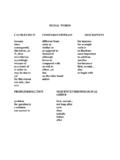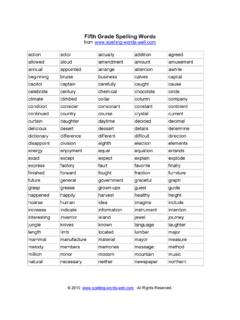Transcription of The Relationship Between Anxiety and Performance: A ...
1 September, 1999 Volume 1, Issue 2 The Relationship Between Anxiety and performance : A Cognitive-Behavioral Perspective Miguel Humara, ABSTRACT This paper examines the Relationship Between Anxiety and performance from a cognitive-behavioral perspective. Previous research in the field has suggested that the majority of consultations conducted by sport psychologists are related to Anxiety . Included is a discussion on the theoretical underpinnings of Anxiety and how it relates to performance . Research conducted on the Relationship Between Anxiety and performance is also discussed.
2 A review of the cognitive-behavioral treatments that have been used for Anxiety reduction and performance enhancement within the field of athletics is included. Suggestions for future research and practical considerations are listed in the conclusion. Introduction The ability to cope with pressure and Anxiety is an integral part of sports, particularly among elite athletes (Hardy, Jones, & Gould, 1996; Orlick & Partington, 1988). Researchers have reported that over 50 of consultations among athletes at an Olympic festival were related to stress or Anxiety related problems (Murphy, 1988).
3 A great deal of research has been conducted examining the Relationship Between Anxiety and performance within the field of athletics. This paper will review the relevant research from a cognitive-behavioral perspective. Included is a discussion of the research findings of the Relationship Between the two constructs. In addition, the research that has examined the efficacy of cognitive-behavioral treatments is also discussed. Although a great deal of information has been generated, the results are limited due problems in the terminology used by researchers.
4 Therefore, it is important to first examine the conceptualization of Anxiety . 1 Theoretical Constructs of Anxiety Previous research conducted relating to Anxiety and performance in athletics has been difficult to synthesize for a variety of reasons including methodological flaws such as a lack of clear operational definitions and a clear theoretical construct. This section will establish operational definitions for the terms that will be used throughout the rest of this paper. In addition, it will provide an overview of the theories that have been used by researchers who have attempted to clarify the Relationship Between Anxiety and performance in athletics.
5 The main problem that research on the Relationship Between Anxiety and performance has encountered is that researchers have not adequately operationally defined the construct of Anxiety . Instead, terms such as stress, Anxiety , arousal and activation have been used interchangeably. For the purposes of this paper the following operational definitions will be used for the terms Anxiety and stress. Stress is a state that results form the demands that are placed on the individual which require that person to engage in some coping behavior (Jones, 1990).
6 Arousal can be considered to be a signal to the individual that he or she has entered a stressful state and is characterized by physiological signs (Hardy et al., 1996). Anxiety results when the individual doubts his or her ability to cope with the situation that causes him or her stress (Hardy et al., 1996). Another important point that needs to be clarified is the difference Between state and trait Anxiety (Spielberger, 1966). While state Anxiety can be considered to be more situational in nature and is often associated with arousal of the autonomic nervous system, trait Anxiety can be thought of as a world view that an individual uses when coping with situations in his or her environment (Spielberger, 1966).
7 Trait Anxiety influences performances in that individuals with high trait Anxiety will attend more to information related to state Anxiety (Hardy et al., 1996). Previous research outside of sport and exercise psychology has indicated that individuals with high trait Anxiety who are state anxious attend to threat related information, while individuals with low trait Anxiety who are state anxious will attend away from threat related information (MacLeod, 1990). Within the context of sports, those individuals who are low trait anxious and experience high state Anxiety would find it facilitative to a peak performance ; but, those individuals with who are high trait anxious and experience state Anxiety will find it debilitative to athletic performance (Hardy et al.)
8 , 1996). One of the earliest models that attempted to explain the Relationship Between arousal and performance was the inverted-U hypothesis (Broadhurst, 1957; Hebb, 1955). It stated that as arousal increased performance would increase as well; but, if arousal became too great performance would deteriorate. In other words, as stress began to build an individual still felt confident in their ability to control it and performance would improve. However, once a stressor became so great that the individual started to doubt the ability to cope with, performance began to decline.
9 Although this model gave some explanation as to why performances deteriorated when individuals felt stress, it did not account for the differences in the performance of athletes who are exposed to the same stressor. 2 Researchers attempted to account for the differences in the performances of individuals through the concept of individualized zones of optimal functioning or IZOFs (Hanin, 1980, 1986). According to this theory, each individual has an optimal level of pre- performance Anxiety which results in peak performances. However, if the pre- performance Anxiety lies outside the area of the IZOF, whether too high or too low, then performance will deteriorate (Hanin, 1980, 1986).
10 IZOFs can be determined by repeatedly measuring Anxiety and performance or through athlete's recall of Anxiety levels prior to peak performances. Indeed, researchers found that IZOFs are better predictors of performance then the inverted U- hypothesis (Turner & Raglin, 1991). Although this is a better model then the inverted-U hypothesis, it still fails to explain the factors that account for the individual differences in performance among athletes. The differences observed Between successful and unsuccessful athletes may be the result of their cognitive interpretation of their Anxiety states.







